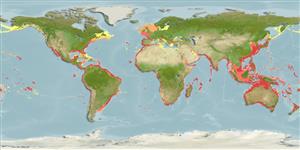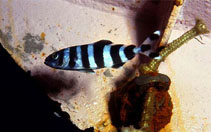مشاهدات خود را اضافه کنيد در Fish Watcher
| Native range | All suitable habitat | Point map | Year 2050 |

|
| This map was computer-generated and has not yet been reviewed. |
| Naucrates ductor AquaMaps Data sources: GBIF OBIS |
را بارگذاری کني تصاوير و فيلم ها
Pictures | Videos | Sounds | تصوير گوگلNaucrates ductor
Picture by Luquet, D.
Pictures | Videos | Sounds | تصوير گوگلNaucrates ductor
Picture by Luquet, D.
Italy country information
Common names:
Fanfalu, Fanfano, Fanfano
Occurrence: native
Salinity: marine
Abundance: | Ref:
Importance: | Ref:
Aquaculture: | Ref:
Regulations: | Ref:
Uses: no uses
Comments:
National Checklist:
Country Information: https://www.cia.gov/library/publications/resources/the-world-factbook/geos/it.html
National Fisheries Authority:
Occurrences: Occurrences Point map
Main Ref: Berry, F.H. and W.F. Smith-Vaniz, 1978
National Database: ICTIMED
Occurrence: native
Salinity: marine
Abundance: | Ref:
Importance: | Ref:
Aquaculture: | Ref:
Regulations: | Ref:
Uses: no uses
Comments:
National Checklist:
Country Information: https://www.cia.gov/library/publications/resources/the-world-factbook/geos/it.html
National Fisheries Authority:
Occurrences: Occurrences Point map
Main Ref: Berry, F.H. and W.F. Smith-Vaniz, 1978
National Database: ICTIMED
Common names from other countries
رده بندی / Names اسامي عام | مترادف | Catalog of Fishes(جنس, گونه ها) | ITIS | CoL | WoRMS | Cloffa
> Carangiformes (Jacks) > Carangidae (Jacks and pompanos) > Naucratinae
Etymology: Naucrates: Greek, naykrates, -es, -es = supremacy in the sea (Ref. 45335).
More on author: Linnaeus.
Etymology: Naucrates: Greek, naykrates, -es, -es = supremacy in the sea (Ref. 45335).
More on author: Linnaeus.
Environment: milieu / climate zone / depth range / distribution range بوم شناسي
دريايي وابسته به آب سنگ; تغييرات عمق 0 - 300 m (Ref. 86942). Subtropical; 61°N - 43°S, 180°W - 180°E
پراكنش كشورها | مناطق سازمان خوار و بار جهاني (FAO) | Ecosystems | ظهور | Point map | معرفي | Faunafri
Circumtropical in tropical seas. Western Atlantic: Nova Scotia, Canada to Argentina (Ref. 7251). Eastern Atlantic: British Isles (rare vagrant), Norway and Bay of Biscay to Namibia, including the Mediterranean and Canary Islands. Eastern Pacific: Vancouver Island (British Columbia, Canada) to the Galapagos Islands (Ref. 2850) and Chile (Ref. 115205). Common throughout the Indian Ocean (Ref. 3197).
Size / Weight / سن
Maturity: Lm ? range ? - ? cm
Max length : 70.0 cm TL جنس نر / بدون خواص جنسي; (Ref. 5288); common length : 40.0 cm TL جنس نر / بدون خواص جنسي; (Ref. 9626)
Max length : 70.0 cm TL جنس نر / بدون خواص جنسي; (Ref. 5288); common length : 40.0 cm TL جنس نر / بدون خواص جنسي; (Ref. 9626)
توصيف مختصر كليدهاي شناسايي | ريخت شناسي | ريخت ستجي بوسيله انداره گيري
خارهاي باله پشتي (کل) : 5 - 6; شعاع نرم باله پشتي (کل) : 25 - 29; خارهاي باله مخرجي: 3; شعاع نرم باله مخرجي: 15 - 17. Body elongate, slender, and not strongly compressed; posterior end of upper jaw located at anterior rim of eye; dorsal fin with 4 or 5 spines followed by another spine and 25 to 29 soft rays (IV-V+I 25-29); lateral line without scutes; caudal peduncle with well developed fleshy keels and with dorsal and ventral peduncular fossae (Ref. 55763). Body dark to pale bluish, with 6-7 broad, dark bars; white tips on caudal lobes and on second dorsal and anal lobes (Ref. 3197).
Oceanic species with a semi-obligate commensal relationship with sharks, rays, other bony fishes and turtles (Ref. 5217). Young are usually associated with jellyfish and drifting seaweed (Ref. 2850, 9563). Feed on scraps of host's left over, parasites and excrement; also on small fishes and invertebrates (Ref. 5288). Eggs are pelagic (Ref. 4233). Marketed fresh and salted or dried (Ref. 9283). Captured at the surface using hand nets (Ref. 26165).
Life cycle and mating behavior بلوغ | تولید مثل | تخم ریزی | تخم ها | Fecundity | توزاد ( لارو)
مآخذ اصلی
Upload your references | مراجع | هماهنگ كننده : Smith-Vaniz, William F. | همكاران
Smith-Vaniz, W.F., J.-C. Quéro and M. Desoutter, 1990. Carangidae. p. 729-755. In J.C. Quero, J.C. Hureau, C. Karrer, A. Post and L. Saldanha (eds.) Check-list of the fishes of the eastern tropical Atlantic (CLOFETA). JNICT, Lisbon; SEI, Paris; and UNESCO, Paris. Vol. 2. (Ref. 7097)
وضعيت در فهرست قرمز IUCN (Ref. 130435: Version 2024-2)
حداقل نگرانی (LC) ; Date assessed: 07 November 2013
خطر برای انسان ها
Harmless
استفاده انسانی
ماهي گيري – شيلات: ارزش تحاري اندك; ماهي ها ي سرگرم كننده: بله; آكواريوم: آکواریوم عمومی
FAO(ماهي گيري – شيلات: production; publication : search) | FishSource | Sea Around Us
اطلاعات بيشتر
Population dynamics
Growth parameters
Max. ages / sizes
Length-weight rel.
Length-length rel.
نوسانات طولی
Mass conversion
بازسازی
فراواني
Growth parameters
Max. ages / sizes
Length-weight rel.
Length-length rel.
نوسانات طولی
Mass conversion
بازسازی
فراواني
Life cycle
تولید مثل
بلوغ
Fecundity
تخم ریزی
Spawning aggregations
تخم ها
نمو تخم
توزاد ( لارو)
پويايي لاروي
تولید مثل
بلوغ
Fecundity
تخم ریزی
Spawning aggregations
تخم ها
نمو تخم
توزاد ( لارو)
پويايي لاروي
Physiology
Body composition
Nutrients
Oxygen consumption
Swimming type
Swimming speed
Visual pigments
Fish sound
Diseases & Parasites
Toxicity (LC50s)
Body composition
Nutrients
Oxygen consumption
Swimming type
Swimming speed
Visual pigments
Fish sound
Diseases & Parasites
Toxicity (LC50s)
Genetics
ژنتيك
Heterozygosity
وارث
ژنتيك
Heterozygosity
وارث
Human related
Aquaculture systems
نمايه هاي آبزي پروري
نژادها
Ciguatera cases
Stamps, coins, misc.
Aquaculture systems
نمايه هاي آبزي پروري
نژادها
Ciguatera cases
Stamps, coins, misc.
ابزارها
Bio-Quiz | E-book | راهنماي صحرايي | كليدهاي شناسايي | امكان نرم افزاري بسامد طولي | ابزار تاريخ زيستي | نقشه نقطه ای | Classification Tree
| Catch-MSY |
گزارش های ويژه
راجع به نگهداری آکواريم ملاحظه کنيد | برگه اطلاعات و مشخصات گونه ها را ملاحظه کنيد | برگه اطلاعات و مشخصات آبزی پروری را ببينيد
بارگيری XML
صفحه خلاصه | Point data | اسامي عام | تصاوير
منابع اينترنتي
Aquatic Commons | BHL | Cloffa | Websites from users | فيش واچر را ببينيد | CISTI | Catalog of Fishes(جنس, گونه ها) | DiscoverLife | DORIS | ECOTOX | Faunafri | Fishtrace | GenBank(ژنوم, نوکلئوتيد) | GloBI | GOBASE | | Google Books | Google Scholar | Google | IGFA World Record | MitoFish | پايگاه هاي داده ها | OsteoBase(skull, spine) | Otolith Atlas of Taiwan Fishes | آکواریوم عمومی | PubMed | Reef Life Survey | Scirus | SeaLifeBase | Tree of Life | Wikipedia(برو, جستجو) | World Records Freshwater Fishing | Zoological Record
Estimates based on models
Preferred temperature (Ref. 115969): 7.9 - 28.1, mean 20.9 (based on 3025 cells).
Phylogenetic diversity index (Ref. 82804): PD50 = 1.0000 [Uniqueness, from 0.5 = low to 2.0 = high].
Bayesian length-weight: a=0.01413 (0.00659 - 0.03029), b=2.93 (2.74 - 3.12), in cm Total Length, based on LWR estimates for this species & (Sub)family-body (Ref. 93245).
Trophic level (Ref. 69278): 3.4 ±0.43 se; based on food items.
جهندگی (Ref. 120179): متوسط, كمينه زمان لازم براي دو برابر شدن جمعيت 4/1 – 4/4 سال (Preliminary K or Fecundity.).
Fishing Vulnerability (Ref. 59153): Moderate to high vulnerability (48 of 100).




